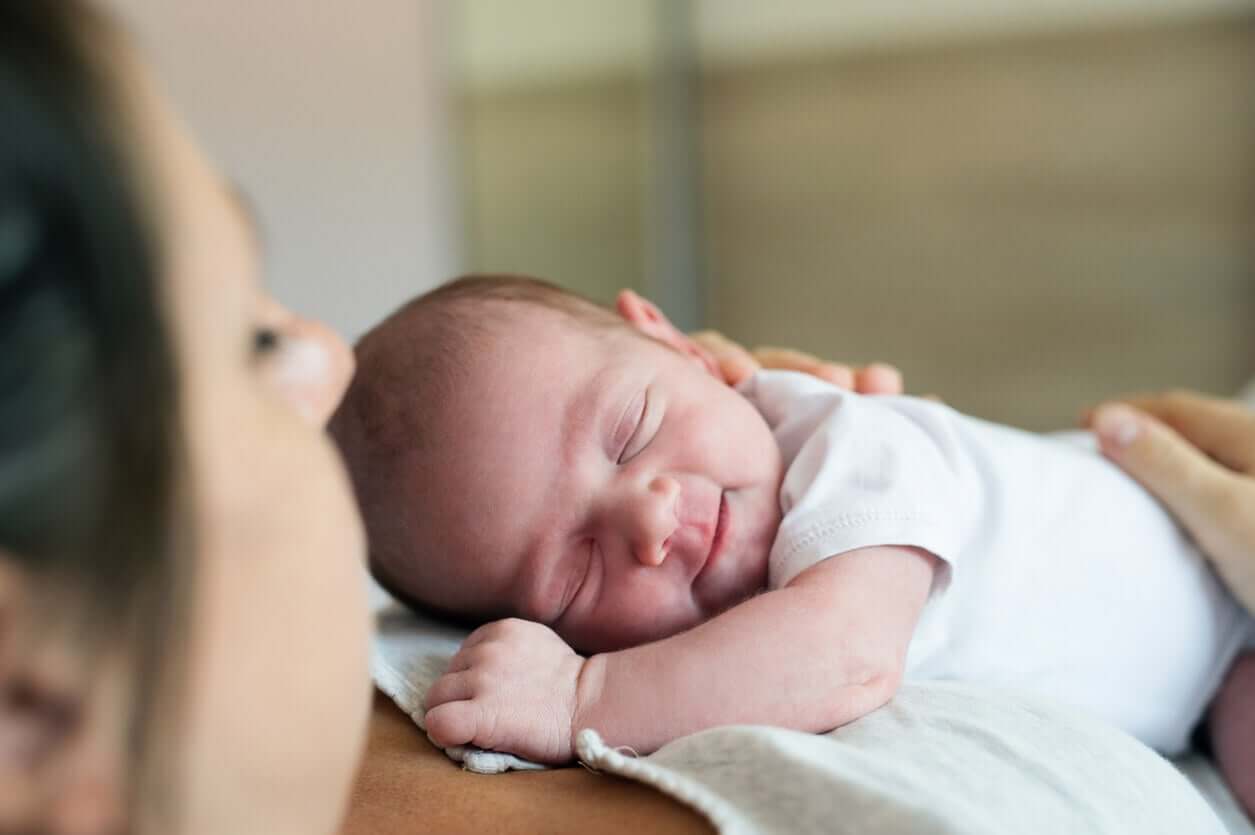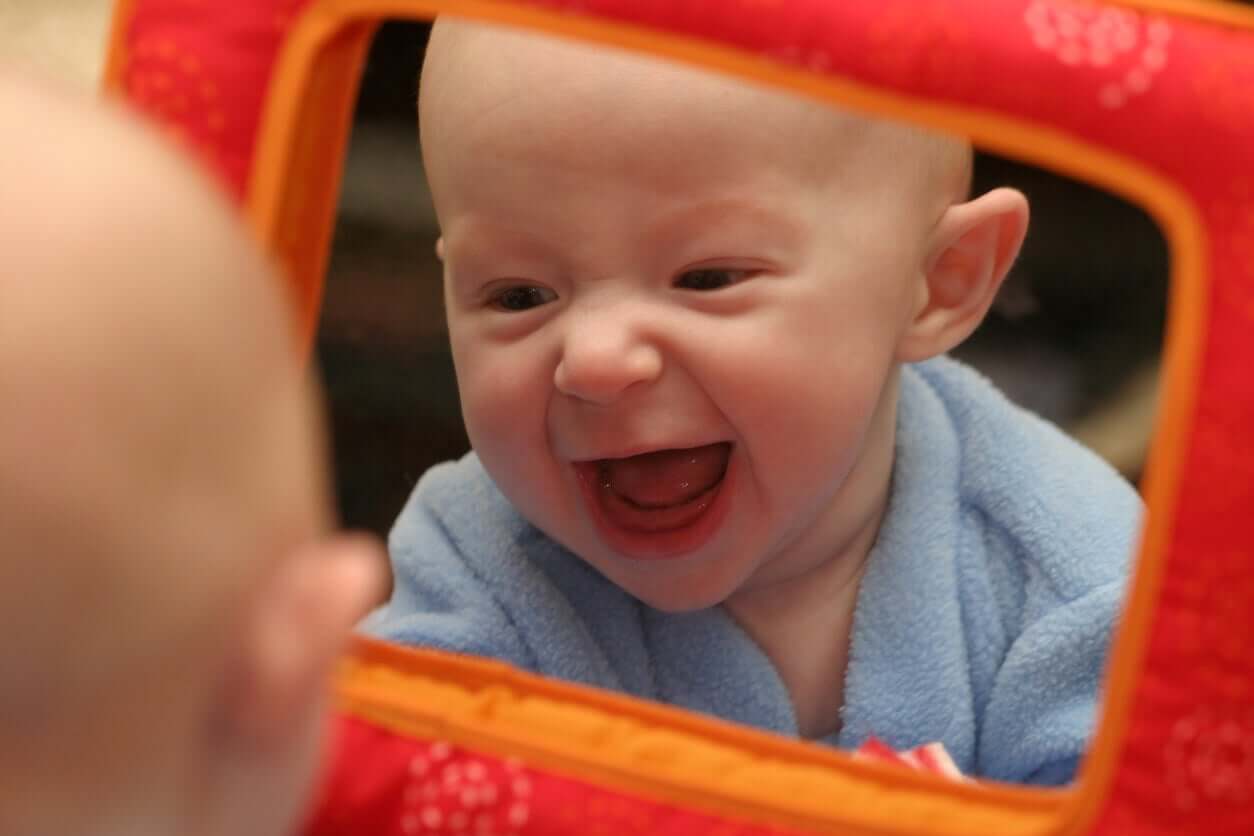How to Make a Baby Laugh?

If you have a baby in the family, be it a son or daughter, nephew or niece, it’s likely that you’ve been touched by a video of them laughing out loud. In general, it’s normal that when we see someone who laughs, we’re tempted to laugh ourselves. But when it comes to a baby, the effect seems to double. Do you know the benefits of making a baby laugh? In this article, we’ll tell you all about them.
Laughter in babies

In babies, laughter isn’t the same as humor. However, it’s an expression of the experience of pleasure.
Although little ones laugh from the time they’re in the womb, during the first weeks of life, it’s more of a reflex.
With the passage of time, that laughter becomes more complex and babies can smile several times a day and even while nursing their mother’s breast. This is because that experience gives them a feeling of great well-being and enjoyment.
Between the first and second months of life, the smile becomes a means of social contact and it’s important that the child’s reference figures accompany and respond to it. Laughter is the new form of communication, and little by little, the baby understands that they can choose another strategy to capture the attention of adults.
Later, children identify that by responding with a smile, they can empathize with other people. Through it, they also show appreciation or get closer to other children and make new friends.
In conclusion, laughter goes from being a simple reflection to becoming an instrument of expression and communication.
You may also be intersted in: When Babies Smile and Laugh: A Big Step In Their Emotional Development
How to make a baby laugh?
Through laughter, unique moments of emotional connection can be generated. Regardless of whether you’re the one who laughs or the one who hears someone laugh, the feeling of relief and pleasure is felt just the same.
Some of the recommendations for making a baby laugh are the following:
- Tickling: Touch always tends to make babies laugh.
- Songs or soft sounds: They also find it very pleasant to hear songs or listen to soft sounds.
- Games: One of the most well-known games for this purpose is playing peek-a-boo. This intermittence of seeing something disappear and reappear tends to be very funny for babies, and then they replicate it with other people.
- Imitations and voice games: Babies often laugh when they hear other people make changes with their voices.
- Mirror: When a baby takes a mirror and looks in it, they have fun for a long time. In this game, the child perceives the movements and gestures of “the other” that are reflected in the accessory.
- Bath time: During bathing, babies can play with the water. By hitting it and splashing it everywhere, they undoubtedly break out laughing.
- Flights in the air: While you’re lying down on your back, you can lift the child on your legs and see their face of astonishment as they take off from the ground. This causes them great laughter, especially when they’re surprised by a change in direction or height.
- Toys: Through toys, such as a rattle or an element with colored lights, we can also attract the attention of a baby and make it fun. When they’re older, we can choose to read stories from storybooks and use different voices to spark laughter.
Of course, not all laughs are the same, but they all achieve the same effect of enjoyment and bonding between babies and their caregivers.
Finally, these are clearly not the only ways to make a baby laugh. Each family knows their child better than anyone and knows what amuses them and what works for them.

Learn more: How to Emotionally Stimulate Your Baby From Birth
Laughter is health
Beyond the tenderness that a baby’s laughter provokes, the truth is that this act has many benefits for them. Laughter is health and this isn’t an exaggeration!
When we laugh, we oxygenate our body better and we improve the activity of our lungs and that of the heart. In turn, we release very powerful neuronal messengers, such as endorphins, serotonin, and dopamine. All of these are known as the “happiness hormones” and help reduce stress and discomfort.
Of course, with this, we don’t want to make an ode to happiness and laughter. Simply, we need to know that by laughing, we not only have a good time but also improve our physical and emotional health.
In line with this, we highlight the importance of promoting the correct development of emotional intelligence from childhood. If we teach children to identify their own emotions and those of others, we’ll raise generations that are much more capable in every way.
If you have a baby in the family, be it a son or daughter, nephew or niece, it’s likely that you’ve been touched by a video of them laughing out loud. In general, it’s normal that when we see someone who laughs, we’re tempted to laugh ourselves. But when it comes to a baby, the effect seems to double. Do you know the benefits of making a baby laugh? In this article, we’ll tell you all about them.
Laughter in babies

In babies, laughter isn’t the same as humor. However, it’s an expression of the experience of pleasure.
Although little ones laugh from the time they’re in the womb, during the first weeks of life, it’s more of a reflex.
With the passage of time, that laughter becomes more complex and babies can smile several times a day and even while nursing their mother’s breast. This is because that experience gives them a feeling of great well-being and enjoyment.
Between the first and second months of life, the smile becomes a means of social contact and it’s important that the child’s reference figures accompany and respond to it. Laughter is the new form of communication, and little by little, the baby understands that they can choose another strategy to capture the attention of adults.
Later, children identify that by responding with a smile, they can empathize with other people. Through it, they also show appreciation or get closer to other children and make new friends.
In conclusion, laughter goes from being a simple reflection to becoming an instrument of expression and communication.
You may also be intersted in: When Babies Smile and Laugh: A Big Step In Their Emotional Development
How to make a baby laugh?
Through laughter, unique moments of emotional connection can be generated. Regardless of whether you’re the one who laughs or the one who hears someone laugh, the feeling of relief and pleasure is felt just the same.
Some of the recommendations for making a baby laugh are the following:
- Tickling: Touch always tends to make babies laugh.
- Songs or soft sounds: They also find it very pleasant to hear songs or listen to soft sounds.
- Games: One of the most well-known games for this purpose is playing peek-a-boo. This intermittence of seeing something disappear and reappear tends to be very funny for babies, and then they replicate it with other people.
- Imitations and voice games: Babies often laugh when they hear other people make changes with their voices.
- Mirror: When a baby takes a mirror and looks in it, they have fun for a long time. In this game, the child perceives the movements and gestures of “the other” that are reflected in the accessory.
- Bath time: During bathing, babies can play with the water. By hitting it and splashing it everywhere, they undoubtedly break out laughing.
- Flights in the air: While you’re lying down on your back, you can lift the child on your legs and see their face of astonishment as they take off from the ground. This causes them great laughter, especially when they’re surprised by a change in direction or height.
- Toys: Through toys, such as a rattle or an element with colored lights, we can also attract the attention of a baby and make it fun. When they’re older, we can choose to read stories from storybooks and use different voices to spark laughter.
Of course, not all laughs are the same, but they all achieve the same effect of enjoyment and bonding between babies and their caregivers.
Finally, these are clearly not the only ways to make a baby laugh. Each family knows their child better than anyone and knows what amuses them and what works for them.

Learn more: How to Emotionally Stimulate Your Baby From Birth
Laughter is health
Beyond the tenderness that a baby’s laughter provokes, the truth is that this act has many benefits for them. Laughter is health and this isn’t an exaggeration!
When we laugh, we oxygenate our body better and we improve the activity of our lungs and that of the heart. In turn, we release very powerful neuronal messengers, such as endorphins, serotonin, and dopamine. All of these are known as the “happiness hormones” and help reduce stress and discomfort.
Of course, with this, we don’t want to make an ode to happiness and laughter. Simply, we need to know that by laughing, we not only have a good time but also improve our physical and emotional health.
In line with this, we highlight the importance of promoting the correct development of emotional intelligence from childhood. If we teach children to identify their own emotions and those of others, we’ll raise generations that are much more capable in every way.
All cited sources were thoroughly reviewed by our team to ensure their quality, reliability, currency, and validity. The bibliography of this article was considered reliable and of academic or scientific accuracy.
- da Silva, Renata, & Calvo Tuleski, Silvana (2014). La actividad infantil y el desarrollo emocional en la infancia. Revista Intercontinental de Psicología y Educación, 16(2),9-30.[fecha de Consulta 29 de Septiembre de 2021]. ISSN: 0187-7690. Disponible en: https://www.redalyc.org/articulo.oa?id=80231541002
- García, E. A. L., Valle, J. F. T., & Bermúdez, C. A. R. (2011). Risa y salud: abordajes terapéuticos. MedUNAB, 14(1), 69-75.
- Rafael Christian, Ramos, J., Susanibar, C., & Balarezo, G. (2019). Risoterapia: Un nuevo campo para los profesionales de la salud. Revista De La Sociedad Peruana De Medicina Interna, 17(2), 57-64. https://doi.org/10.36393/spmi.v17i2.238
This text is provided for informational purposes only and does not replace consultation with a professional. If in doubt, consult your specialist.








